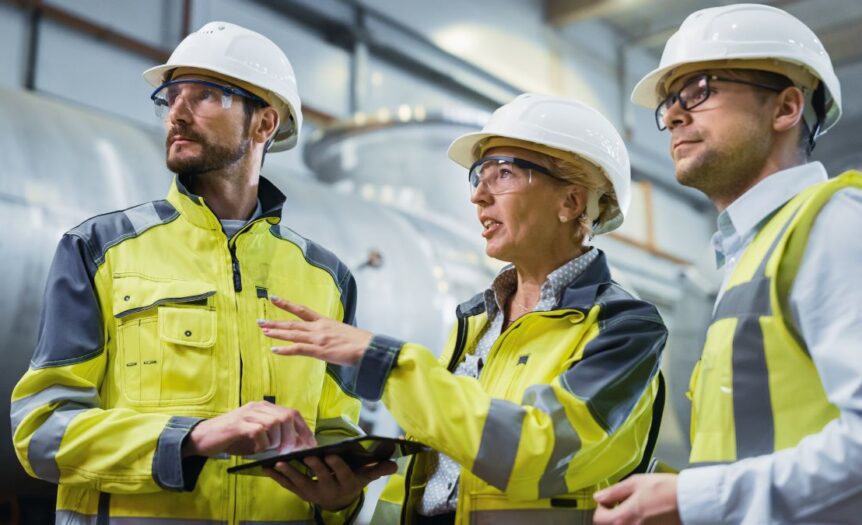Ensuring the safety of workers on a worksite is paramount, not only for the well-being of the employees but also for the smooth operation and reputation of any construction or industrial project. It involves a multifaceted approach that includes rigorous safety protocols, continuous education, and adopting the latest safety technologies.
Let’s look at how to ensure worker safety on a worksite and the crucial steps every employer and worker must take to create a safe working environment.
The Importance of Worker Safety
The construction and industrial sectors are among the most hazardous industries, with a high rate of on-site injuries and fatalities. This danger highlights the need for strict safety measures to protect workers from hazards like falls, electrocution, equipment malfunctions, or exposure to harmful substances.
A safe worksite protects workers and boosts their morale and productivity, leading to a more efficient and successful project. It also demonstrates an employer’s commitment to their employees’ well-being, promoting a positive work culture.
Key Steps for Ensuring Worker Safety on a Worksite
Here are some actions to take to maximize worker safety.
Do a Thorough Risk Assessment
Before any construction or industrial project begins, a comprehensive risk assessment must occur. This assessment involves identifying potential hazards and evaluating the level of risk they pose to workers’ safety. A thorough risk assessment helps implement appropriate safety measures and protocols.
Hold Proper Training
All employees, including managers and supervisors, should undergo regular safety training. They should have the knowledge and skills to identify hazards, handle emergencies, and correctly use safety equipment. Knowing mistakes to avoid when using worksite PPE and how to handle dangerous situations can prevent accidents.
Implement Safety Protocols
Safety protocols are essential guidelines that outline the necessary precautions and procedures you should follow on a worksite. These should include measures like wearing personal protective equipment (PPE), conducting frequent inspections, and adhering to safety standards that relevant authorities have set.
Use Technology
Advancements in technology have made it possible to incorporate safety measures into worksites. For instance, drones for site inspections or wearable technology that alerts workers of potential hazards can significantly improve worker safety.
Perform Regular Maintenance
Proper maintenance and equipment inspection are vital for ensuring worker safety. Faulty equipment can lead to accidents and injuries, so regular checks and repairs are crucial.
Promote Safety Culture
Creating a safe working environment isn’t solely the responsibility of employers; workers also have a role to play. Employers should encourage employees to prioritize safety and promptly report any potential hazards or injuries.
Ensuring worker safety on a worksite requires collaboration between all parties, including employers, workers, and relevant authorities. By following these key steps and continuously educating and updating safety measures, you can create a safer working environment for all workers. Remember that safety should always be the top priority on any worksite.










 Deering Estate
Deering Estate
 Massage Envy South Miami
Massage Envy South Miami
 Calla Blow Dry
Calla Blow Dry
 My Derma Clinic
My Derma Clinic
 Sushi Maki
Sushi Maki
 Sports Grill
Sports Grill
 The Healthy Kitchen
The Healthy Kitchen
 Golden Rule Seafood
Golden Rule Seafood
 Malanga Cuban Café
Malanga Cuban Café

 Kathleen Ballard
Kathleen Ballard
 Panter, Panter & Sampedro
Panter, Panter & Sampedro
 Vintage Liquors
Vintage Liquors
 The Dog from Ipanema
The Dog from Ipanema
 Rubinstein Family Chiropractic
Rubinstein Family Chiropractic
 Your Pet’s Best
Your Pet’s Best
 Indigo Republic
Indigo Republic




 ATR Luxury Homes
ATR Luxury Homes


 2112 Design Studio
2112 Design Studio
 Hamilton Fox & Company
Hamilton Fox & Company
 Creative Design Services
Creative Design Services
 Best Pest Professionals
Best Pest Professionals
 HD Tree Services
HD Tree Services
 Trinity Air Conditioning Company
Trinity Air Conditioning Company
 Cisca Construction & Development
Cisca Construction & Development
 Mosquito Joe
Mosquito Joe
 Cutler Bay Solar Solutions
Cutler Bay Solar Solutions


 Miami Royal Ballet & Dance
Miami Royal Ballet & Dance
 Christopher Columbus
Christopher Columbus
 Pineview Preschools
Pineview Preschools
 Westminster
Westminster
 Carrollton
Carrollton
 Lil’ Jungle
Lil’ Jungle
 Frost Science Museum
Frost Science Museum
 Palmer Trinity School
Palmer Trinity School
 South Florida Music
South Florida Music
 Pinecrest Orthodontics
Pinecrest Orthodontics
 Dr. Bob Pediatric Dentist
Dr. Bob Pediatric Dentist
 d.pediatrics
d.pediatrics
 South Miami Women’s Health
South Miami Women’s Health

 The Spot Barbershop
The Spot Barbershop
 My Derma Clinic
My Derma Clinic




 Miami Dance Project
Miami Dance Project

 Rubinstein Family Chiropractic
Rubinstein Family Chiropractic
 Indigo Republic
Indigo Republic

 Safes Universe
Safes Universe
 Vintage Liquors
Vintage Liquors
 Evenings Delight
Evenings Delight





 Atchana’s Homegrown Thai
Atchana’s Homegrown Thai
 Baptist Health South Florida
Baptist Health South Florida

 Laser Eye Center of Miami
Laser Eye Center of Miami
 Visiting Angels
Visiting Angels
 OpusCare of South Florida
OpusCare of South Florida

 Your Pet’s Best
Your Pet’s Best





 HD Tree Services
HD Tree Services
 Hamilton Fox & Company
Hamilton Fox & Company


 Creative Design Services
Creative Design Services